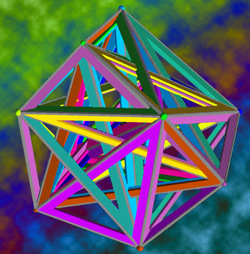Hamish Johnston
PhysicsWebMon, 09 Apr 2007 05:08 UTC
As any experienced angler will know, some knots are better than others -- but exactly why a "blood knot" should be stronger than, say, a "reef knot" is far from clear. Now, physicists in Japan have tried to unravel this mystery by carrying out the first experiments into how fishing lines with knots in them actually break. Surprisingly, it turns out that some knots that are strong when made using traditional nylon fishing line are in fact the weakest when made in a more modern material called PVDF
Determining exactly where a knot breaks in a material is not easy. First, the shape of the knot changes as it is tightened. Second, it is difficult to watch how the broken strands recoil, which takes place very quickly. Third, most knots unravel after breaking, making it hard to reconstruct a broken knot.
Hamish Johnston
PhysicsWebMon, 09 Apr 2007 05:05 UTC
Sandstone and granite are very different types of rock, so it might come as a surprise that both materials appear to crack in the same way -- at least according to physicists in Canada and Germany who have measured the sounds given off by rocks before they shatter. What's even more curious is that sounds from the small samples of rock studied by the group have similar characteristics as those detected after an earthquake, suggesting cracking is a universal process that occurs in many different materials over a wide range of size and time scales
Humans have been cracking rocks for at least one million years - first to make tools and then to quarry and shape building materials. While both stone-age toolmakers and modern-day mechanical engineers have developed a practical understanding of the cracking process, a microscopic theory of cracking has remained elusive. The problem is that most rocks are made of grains that come in many different shapes and are arranged in many different ways. This makes it very difficult to predict when and where a crack will begin and how it will propagate.
NASA officials say the space agency is capable of finding nearly all the asteroids that might pose a devastating hit to Earth, but there isn't enough money to pay for the task so it won't get done.
The cost to find at least 90 percent of the 20,000 potentially hazardous asteroids and comets by 2020 would be about $1 billion, according to a report NASA will release later this week. The report was previewed Monday at a Planetary Defense Conference in Washington.
Congress in 2005 asked NASA to come up with a plan to track most killer asteroids and propose how to deflect the potentially catastrophic ones.
To David Morrison, a senior scientist at NASA, the Earth orbits the sun in a sort of cosmic shooting gallery. More than 1 million asteroids spin around the sun, and it is Morrison's job to figure out which of these bodies of rock, dust and metal could come crashing down on Earth.
Right now, NASA is tracking 127 asteroids that have a very small chance of striking the planet. That number is about to get a lot higher. Stronger telescopes, and a new mandate from Congress, will allow scientists to detect thousands of smaller asteroids more likely to hit Earth. And scientists are plotting ways to stop them, from "gravity tractors" to solar ray guns.
An underwater survey off San Diego has revealed geological details of how sand builds up along Southern California's continental shelf and could help resource managers to locate deposits to rebuild beaches, according to a report by scientists at Scripps Institution of Oceanography at UC San Diego.
The newly acquired data show the depth of sand levels along 10 kilometers (6.2 miles) of shoreline from La Jolla Cove north to Torrey Pines State Beach and how the sediments are distributed on the shallow, gently sloping seabed adjacent to the shoreline.
The scientists also identified an area of the seafloor uplifted offshore of Torrey Pines State Park that results from a jog in the Rose Canyon fault, similar to the uplift that created Mount Soledad. This uplifted area appears to play a major role in the accumulation of sand in the area, according to Leah Hogarth, a Scripps graduate student and lead author of the article in the journal Geology of the Geological Society of America.
Livermore researchers have moved one step closer to being able to turn on and off the decay of a nuclear isomer.
The protons and neutrons in a nucleus can be arranged in many ways. The arrangement with the lowest energy is called the ground state and all others are called excited states. (This is analogous to the ground and excited states of electrons in an atom except that nuclear excited states are typically thousands of times higher in energy.) Excited nuclear states eventually decay to the ground state via gamma emission or to another nucleus via particle emission. Most excited states are short-lived (e.g., billionth of a second). However, a few are long-lived (e.g., hours) and are called isomers.
Turning the decay on and off is key to using isiomers as high-energy density storage systems such as batteries.
Researchers at Livermore studied an isomer of Thorium-229. This isomer is unique in that its excitation energy is near optical energies, implying that one day scientists may be able to transition Th229 nuclei between the ground and isomeric states using a table-top laser.
"This would then be the first time human control would be exerted over nuclear levels," said Peter Beiersdorfer, an LLNL physicist and co-author of a paper that appears in the April 6 issue of Physical Review Letters. "This only works if the laser is tuned to exactly the correct energy."
Jaron Lanier
Discover Sun, 08 Apr 2007 07:21 UTC
A lifelong obsession leads to the mysterious hedecatope - a seemingly impossible geometric form that, in its own small way, links together the whole universe.

|
| ©Computer model courtesy of Carlo Sequin
|
In this 3-D slice of the four-dimensional
hendecatope, colored beams represent the
edges of triangles; some triangles are left
out for simplicity.
|
A serene orb of ice is set against the gentle pastel clouds of giant Saturn. Rhea transits the face of the gas giant, whose darkened rings and their planet-hugging shadows appear near upper right.

|
| ©NASA/JPL/Space Science Institute
|
The microeconomic law of diminishing marginal utility states that while accumulating a good - pretzels, pencils, nickels, whatever - each successive unit of that good will be less satisfying to acquire than the one before it. Finding a shiny quarter on the street is a real thrill. But, if you are carrying around a bag of coins, acquiring another one does not seem nearly as exciting. In fact, would you even bother to pick it up?
That hesitation is what researchers at the University of Cambridge in England were banking on when they designed a study to see if the haves catch on more slowly than the have-nots when it comes to reward-based learning. Reporting in the current issue of Neuron, the scientists reveal that when a small sum of money is on the line, poorer people learn quickly how to maximize their profits, leaving their wealthier counterparts in the dust.
Lisa Zyga
PhysorgFri, 06 Apr 2007 18:04 UTC
Economists who yearn for the redistribution of wealth in an ideal society are up against history. According to a recent study, the uneven distribution of wealth in a society appears to be a universal law that holds true for economies in many different societies, from ancient Egypt to modern Japan and the U.S. This distribution may reflect a simple natural law analogous to a 100-year-old theory describing the distribution of energy in a gas.
Scientists Arnab Chatterjee and Bikas Chakrabarti from the Saha Institute of Nuclear Physics, along with Sitabhra Sinha of the Institute of Mathematical Sciences, both in India, have analyzed a variety models explaining different sets of data, and found striking similarities. The results show that the poorer majority of the population follows one distribution, while a small proportion of the wealthiest people veers off in a tail following a power-law distribution, in essence reflecting how "the rich get richer."
The studies included large sets of data from sources such as income tax returns and net values of assets in societies including Japan, the U.S., the UK, India, and nineteenth century Europe. The data, taken from a large number of recent publications by several groups, represented a variety of different economies and stages of development. Generally, the lower 90% of the population (in terms of income) followed a log-normal distribution, characterized by an initial rapid rise in population followed by a rapid fall as income increased.
